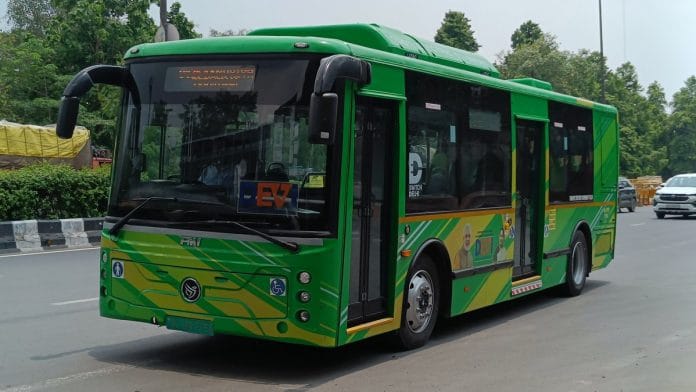New Delhi: Manoj Singh has spent many hours of his life waiting for a DTC bus at his bus stop in Narela over the past decade. Enough time to measure in weeks. Now he has reason to hope the coming years will be different. A typical 15-minute wait has dropped to five.
Last month, Singh watched 105 new orange DEVI buses roll out from the Narela depot with fresh paint and political fanfare, flagged off by Chief Minister Rekha Gupta. The depot was new too—built in just 90 days, with bus bays, hi-tech sheds, RO plants, EV charging stations, and canteens for staff and passengers. The excitement reminded him of DTC’s glory days, about 15 years ago.
“I have seen and experienced DTC’s golden time around the Commonwealth Games in 2010 when buses were very frequent. But in the last one decade I have lost so much time waiting,” said 46-year-old Singh, who has been using DTC buses for around 20 years. “It’s a big change for me.”
The ‘lost decade’ of the Delhi Transport Corporation may finally be coming to an end. The new BJP-led government is positioning itself as the saviour of the DTC.
In the last four months more than 400 DEVI (Delhi Electric Vehicle Interconnector) buses have hit the road, depots are being upgraded, and new routes are being planned. DTC, whose very survival was once in doubt, now appears to be heading toward an electric, more efficient future.
We are not just holding meetings but working to make DTC profitable. We will do what has not been done in so many years. We will change the DTC system
-Pankaj Kumar Singh, Delhi Transport Minister
But there is a lot to recover from. In the last decade under successive Congress and AAP governments, DTC had been reduced to a vehicle of welfare and was facing a serious internal crisis from heavy operational losses, regular strikes, decline in ridership, and shortage of buses.
“Buses are Delhi’s lifeline. But under the previous government, routes were cut, buses reduced, and corruption seeped in,” said CM Gupta at the Narela inauguration where she promised new beginnings.
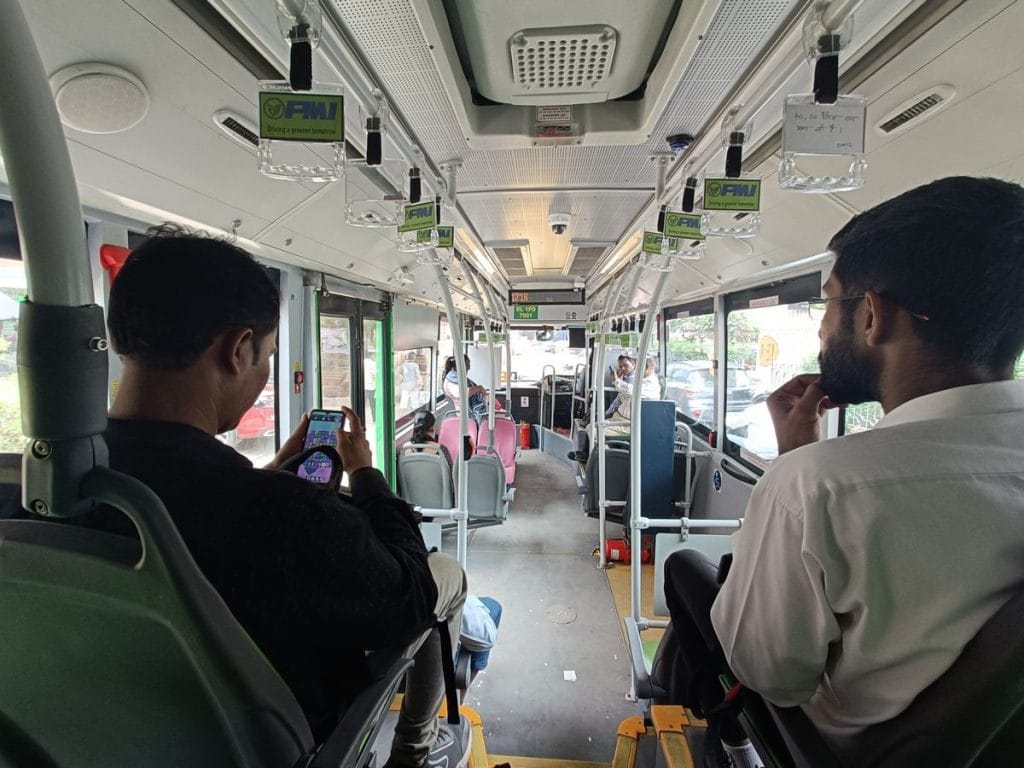
This kind of buoyancy was last seen during the Commonwealth Games, but it fizzled out almost as quickly as it began. Only two buses were inducted between 2011 and 2022. Operational losses between 2015 and 2022 crossed Rs 14,000 crore. Daily ridership plummeted.
“The DTC gained momentum around the Commonwealth Games but it wasn’t maintained,” said Anshu Prakash, former Delhi chief secretary and DTC chairman-cum-managing director from 2006 to 2008. “There was no serious effort to sustain the fleet. Continuing operational losses can’t work. We need more buses in the city and to earn revenue from operations.”
Also Read: The politicians who built Delhi’s Wazirpur slum. Its jhuggi to JCB story
From model fleet to mess
At his home in Delhi, Anshu Prakash sat with stacks of papers detailing the specifications of buses procured during what he called the “watershed years” of 2006 to 2010.
Before that, the buses were basically trucks with windows, he said, but they brought in monocoque chassis, low floors, rear engines.
Back then, CM Sheila Dikshit took a close interest in bus procurement decisions, down to the colour of the buses. “Initially, green was proposed for AC buses and red for non-AC. But when the file went to her, she reversed it,” he recalled.
The 2010 Commonwealth Games were a high point — a modernised fleet, new routes, a sense of ambition. But in the decade that followed, DTC slipped into neglect. Nearly half the fleet aged out while new buses never arrived. It became a case study in inertia, despite occasional attempts at revitalisation.
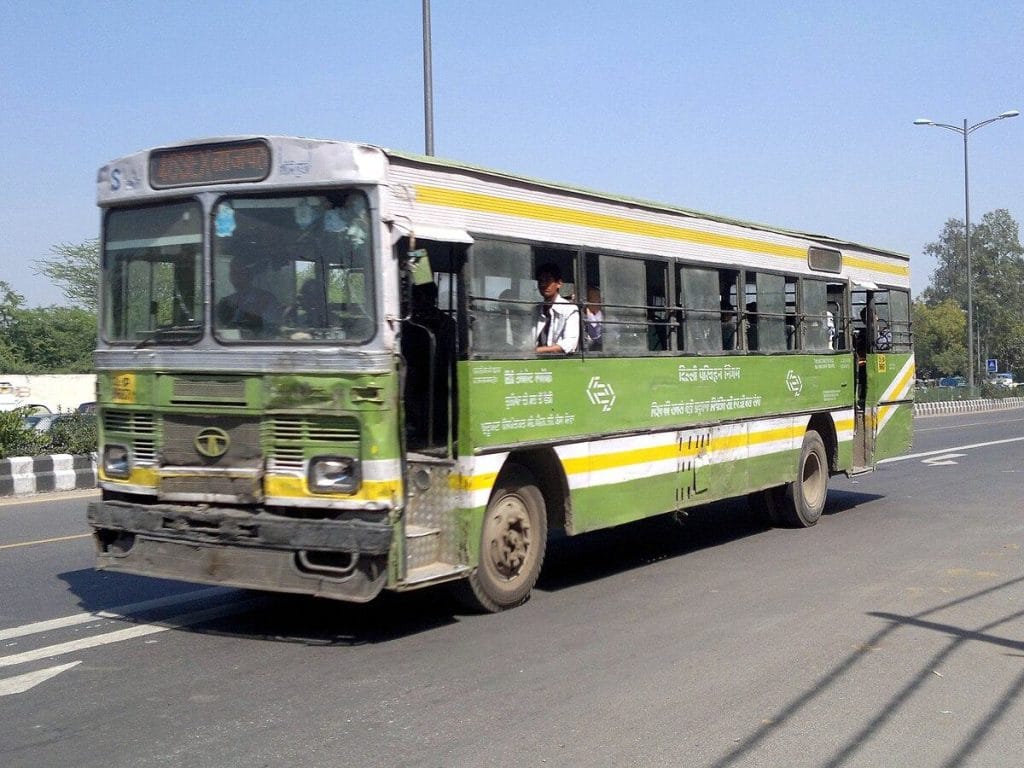
“DTC is trapped in internal management problems from procurement of buses to revenue losses to contractual job issues,” said Satya Prakash, in-charge of the Hasanpur depot and associated with DTC for the last two decades. Two hundred buses run from his depot on 19 different routes.
There was a time when Delhiwalas were dependent on buses and had a close connection with them, as part of daily life, but now the scenario has changed, according to him.
“It’s because no one has attempted a serious effort to run this department properly,” he added.
For the first time (in run-up to CWG), low-floor buses were introduced in any Indian city. Buses became a source of pride. There was a big change in people’s bus travel experience. That was a very satisfying time
– Anshu Prakash, former DTC CMD
Most political promises led nowhere. One glaring example is the cycle of assurances and strikes around contractual jobs. Of DTC’s approximately 30,000 employees, the majority are drivers and conductors on contract.
During the 49-day AAP government in 2013, Arvind Kejriwal joined a DTC staff strike and promised permanent jobs if his party returned with a majority. Many drivers and conductors campaigned for him in the elections, recalled Lalit Chaudhary, president of the DTC Karamchari Ekta Union and a second-generation employee. But nothing changed.
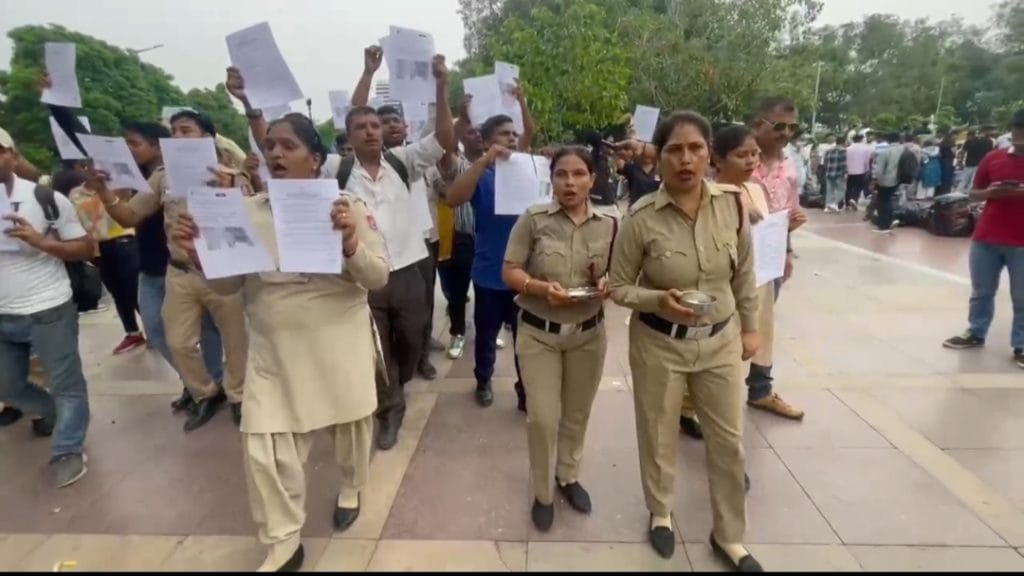
Over the last five years, contract staff have intermittently held bike rallies, hunger strikes, and Labour Day protests for permanent status and equal pay. Ahead of the 2025 Delhi elections, this became a poll issue. The BJP promised to solve all their problems within 60 days of coming to power. Congress MP Rahul Gandhi rode a DTC bus and spoke to drivers, conductors, and marshals. “It is important to listen to their Mann Ki Baat,” Priyanka Gandhi posted on X. But months later, a strike by contract DTC staff in November threw the city into chaos for several days.
Chaudhary said every government ignored the elephant in the room, and now the crisis had become “as big as a demon”.
“People had trust in DTC but now that feeling has gone,” he added.
Running on empty
DTC has been running on fumes for a long time now. During the previous Congress and AAP governments in the last 15 years, its revenue losses and debt have only worsened. Commuters bore the brunt, with fewer buses and shrinking routes.
DTC’s accumulated losses ballooned from Rs 25,299 crore in 2015-16 to over Rs 60,000 crore by 2021-22, despite regular revenue grants from the Delhi government, according to a CAG report, released earlier this year. Operational losses alone crossed Rs 14,000 crore in that period.
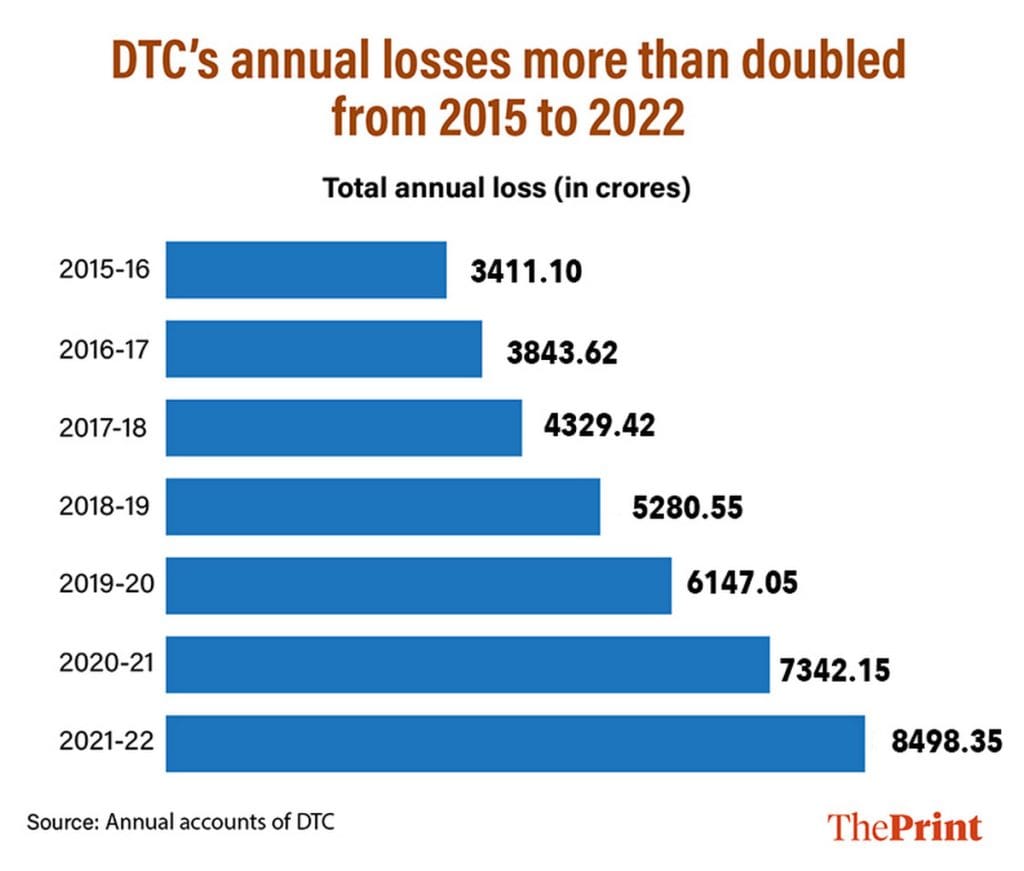
These losses tell the story of a system in stasis. Fare prices haven’t been revised since 2009. Interstate bus services—once a major source of revenue—have been defunct for over 15 years. Efforts to commercialise DTC properties were long absent, although now the corporation hopes to raise Rs 2,600 crore by developing depots at Banda Bahadur Marg and Sukhdev Vihar for parking, advertising, and mobile tower leases.
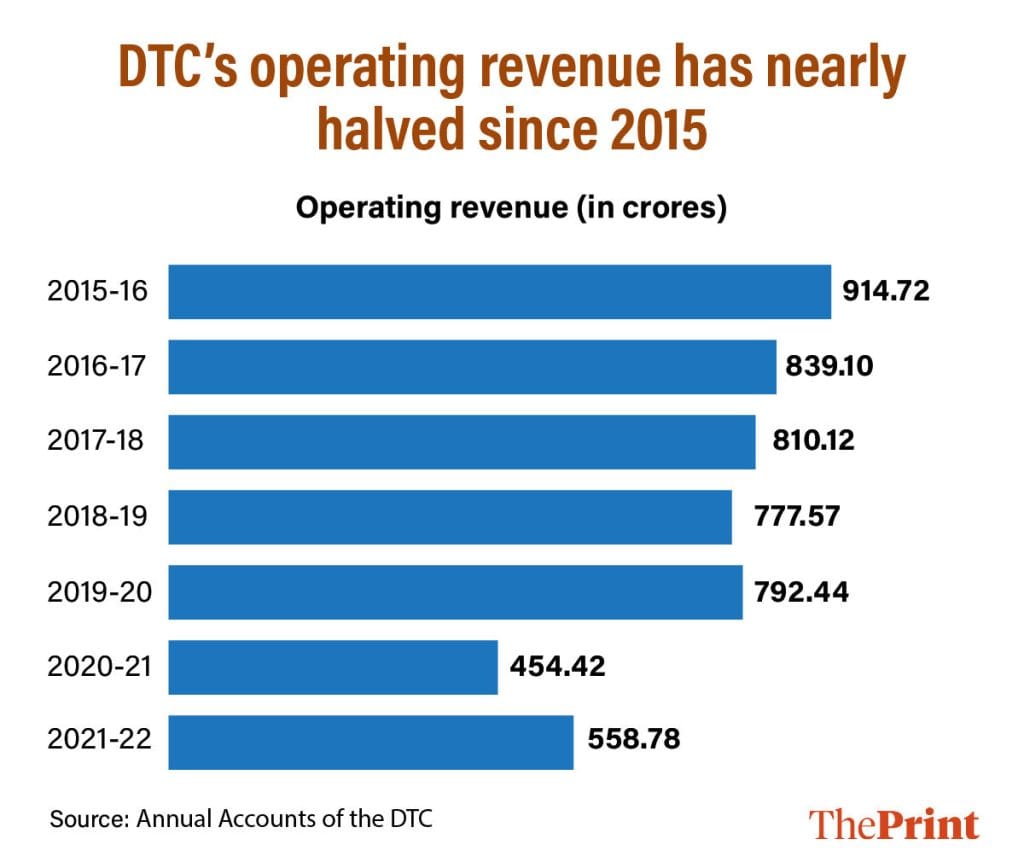
But one of the most glaring failures was the state of the fleet itself. Between 2011 and 2022, DTC added just two buses. And with buses retiring and not being replaced, the fleet shrank from 4,344 in 2015-16 to 3,937 in 2022-23.
According to the latest data maintained by DTC, the current fleet stands at 3,603, including over 2,000 electric vehicles and around 1,300 CNG low-floor buses running on 463 NCR routes. But many of the CNG buses are on their last legs—overage low-floor buses rose from 0.13 per cent in 2018-19 to nearly 45 per cent in 2022-23. Most are being phased out this year.
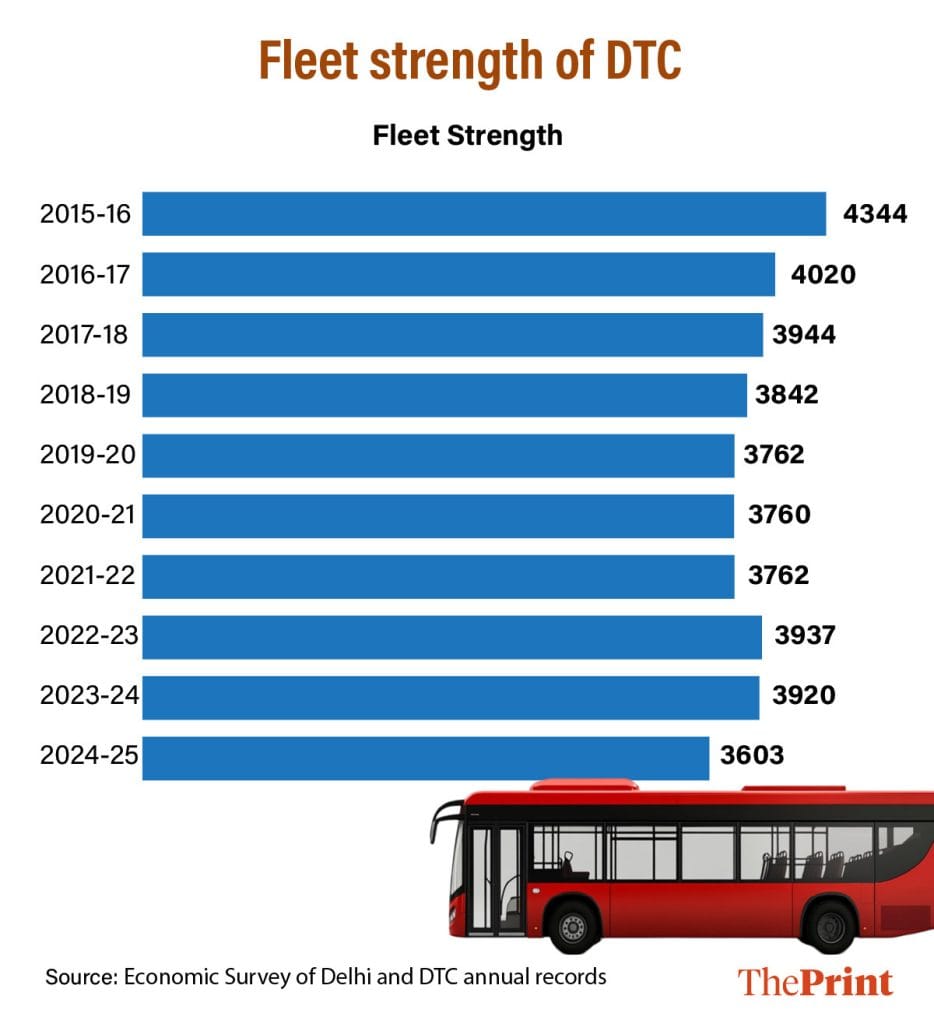
Between 2013 and 2021, when Arvind Kejriwal was CM, the DTC board cleared nine proposals to procure buses. None of them materialised. In 2022, then Delhi LG Anil Baijal ordered an inquiry into alleged irregularities in a tender for 1,000 low-floor buses, following complaints from BJP leader Vijender Gupta.
The CAG report, titled Functioning of Delhi Transport Corporation report, also flagged this. “These could not progress to the tendering stage either due to non-receipt of formal approval from Government of National Capital Territory of Delhi (GNCTD) or change in specifications by GNCTD,” it noted.
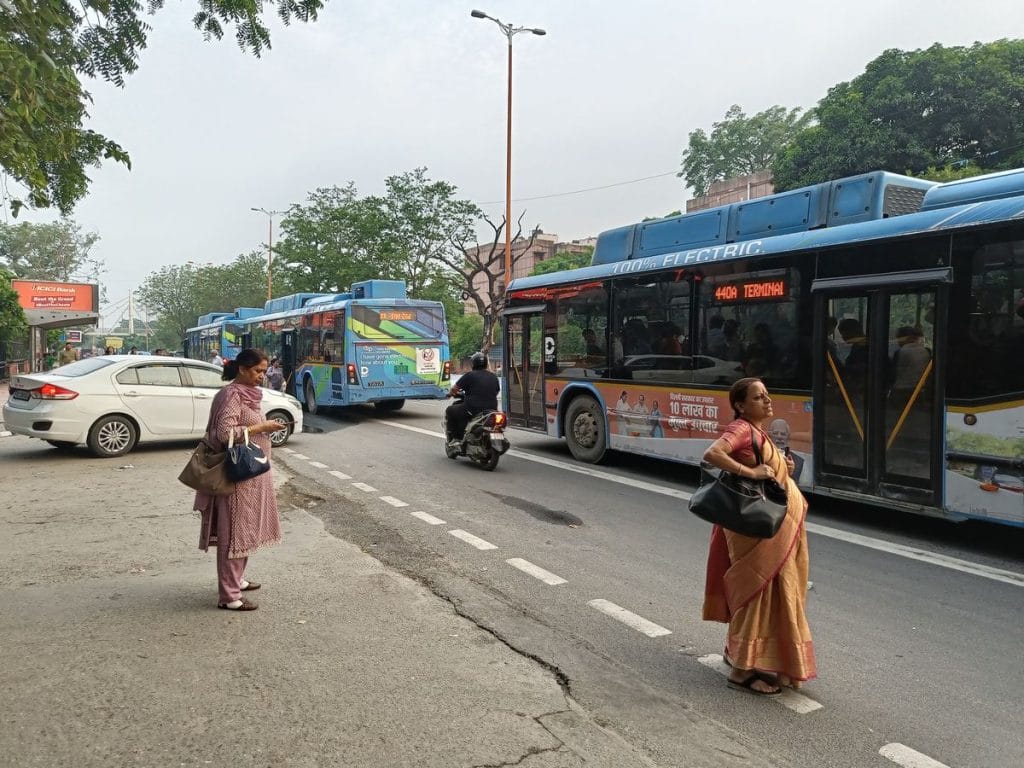
As Delhi’s population grew and pollution levels rose, the need for reliable public transport became more urgent. But DTC’s decline only sped up, with frequent strikes and an average of more than 100 buses breaking down each day.
It didn’t help matters that the AAP government’s 10-year tenure was marked by repeated clashes with the LG and bureaucracy.
“The government was also busy fighting with officials and LG which halted many revival efforts. What was already dead continues to die. DTC is not the first love of any government and always treated with disdain,” said a senior government official who served during the AAP years.
Overall, it seemed like the end of an era for buses. Delhi, like many cities, has prioritised car-centric infrastructure and its metro while neglecting buses.
Between 2019 and 2025, the daily ridership of the metro jumped from 50 lakh per day to 65 lakh, while daily bus ridership declined from 33 lakh to 14.5 lakh. But buses are still essential for last-mile connectivity and affordable short commutes within the city.
“Instead of aspiring for projects like the metro, we need to develop our public transport system based on the city’s population, existing infrastructure, and usage preferences,” said Avinash Chanchal, campaign manager at Greenpeace India.
Modernisation of fleet
DTC is now in the middle of its biggest fleet overhaul in well over a decade, but a push for modernisation started a few years ago under the AAP dispensation.
In January 2022, Kejriwal flagged off the first electric bus at Indraprastha depot—DTC’s first new bus since 2011. “People used to say DTC was jinxed. That has been overcome,” he said, after a ceremonial hawan at the launch.
In 2023, the AAP government placed an order for over 2,000 electric buses to be added to its fleet by December 2025. Now, Delhi’s new BJP government has taken up the mantle in a big way.
Since taking office, CM Rekha Gupta has chaired a series of meetings focused on DTC’s future. In a high-level review on 15 July, she called DTC a loss-making entity weakened by years of mismanagement and promised a full transformation into a robust transport service, according to officials present. Plans are now underway to increase both small and large buses, and new routes are being strategically planned.
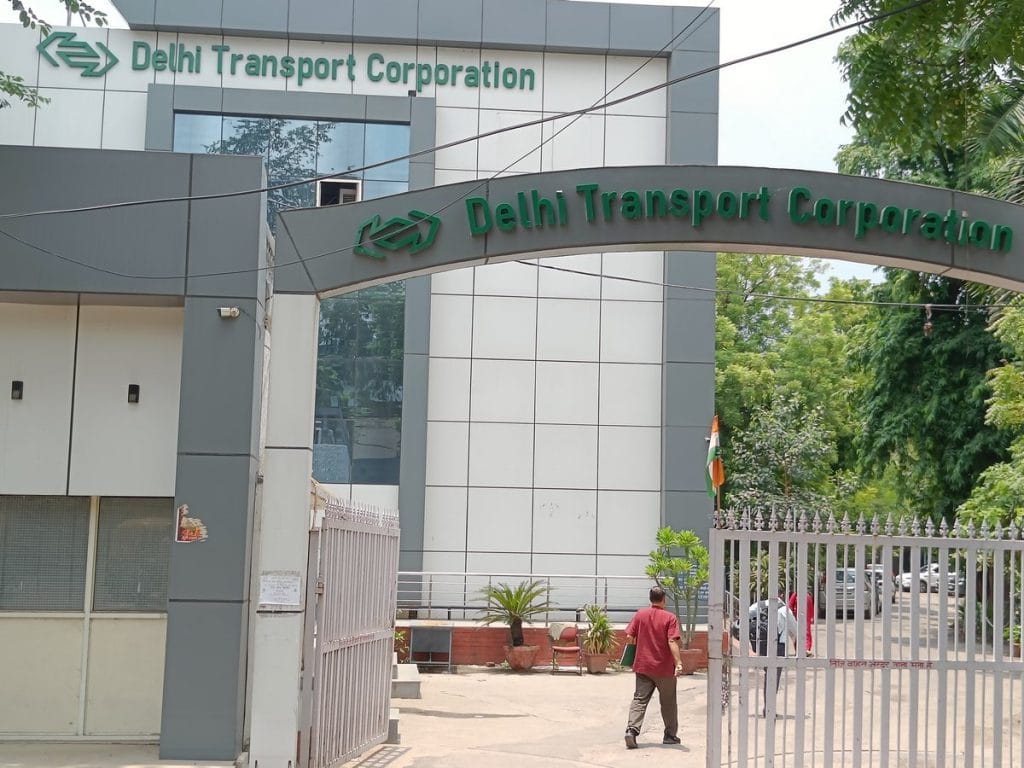
Several depots had already begun transitioning to electric under the previous government. Hasanpur, for instance, was converted from a CNG depot into an electric one last year, with 30 charging stations and a newly built office. It now houses nearly 200 buses.
According to DTC officials, there are currently 1,800 electric buses of 12-metre length and 404 of 9-metre length running on Delhi’s roads.
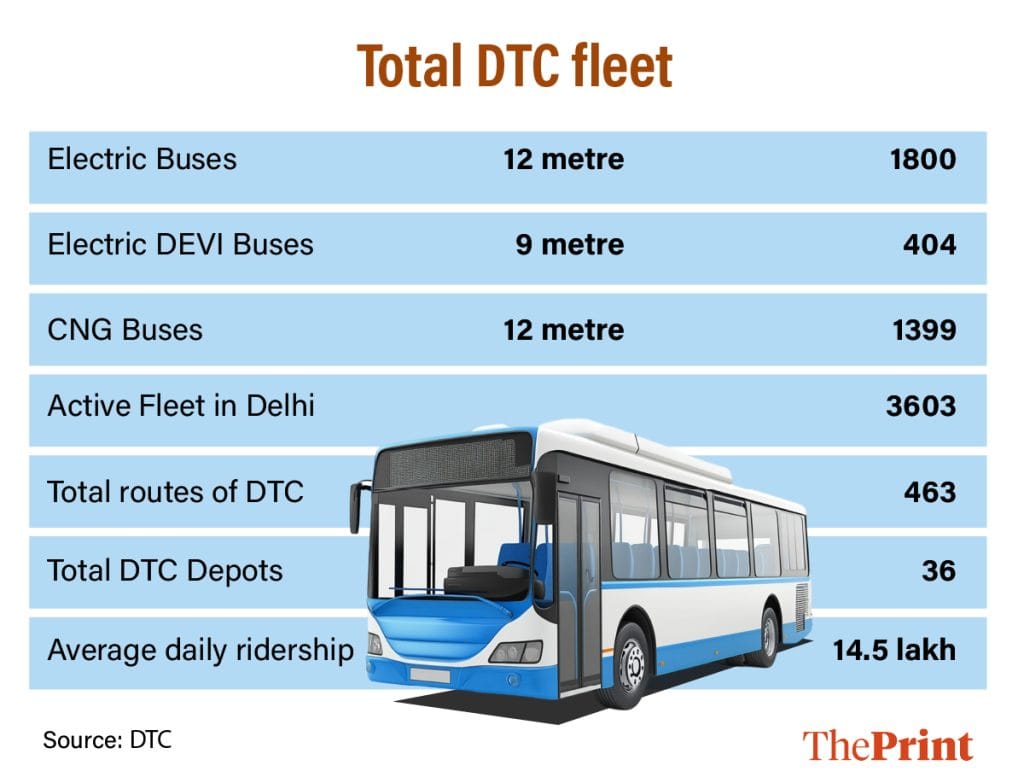
‘I have gone electric. How about you? 100% electric, 0% smoke’ reads the side of one of the buses at Hasanpur depot. Some even carry more political messages—’Upekshit rahi saalon saal, ab badal raha Yamuna ka haal’ (The Yamuna’s neglect is ending), reads one at the JLN Stadium stop.
“DEVI buses are designed for shorter routes and last-mile connectivity. In the last few months, 404 DEVI buses have been flagged off, and the rest will come by the end of this year,” said Navneet Choudhary, deputy CGM (mechanical), DTC.
The fare structure ranges from Rs 10 to Rs 25, and travel is free for women passengers. On World Environment Day, PM Modi flagged off 200 e-buses, calling it a step towards improving Delhiites’ quality of life.
Delhi Transport Minister Pankaj Kumar Singh said the government was committed to reviving DTC.
“We are not just holding meetings but working to make DTC profitable. We will do what has not been done in so many years,” he said. “We will change the DTC system.”
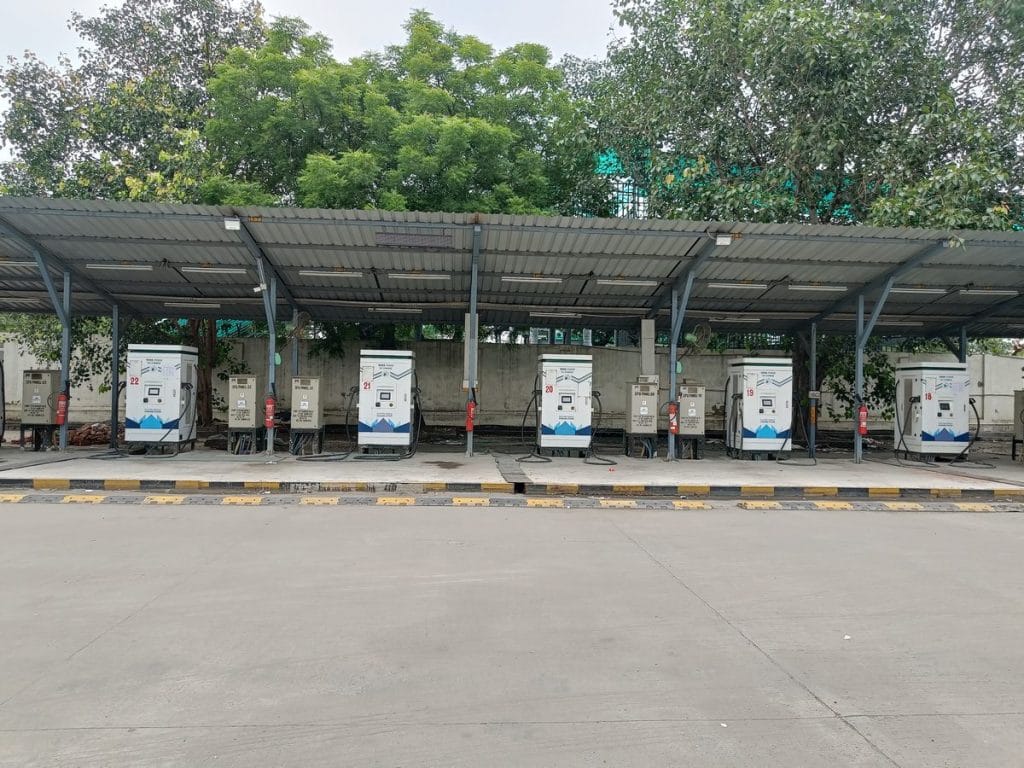
It’s reminiscent of some other heady moments in DTC’s history. First in 2001, when the entire fleet was converted to CNG. Then in the run-up to the Commonwealth Games, when over 3,000 low-floor buses were added; all of those buses completed their operational life around 2022.
“For the first time, low-floor buses were introduced in any Indian city. Buses became a source of pride,” recalled former DTC CMD Anshu Prakash, sipping tea at his residence. “There was a big change in people’s bus travel experience. That was a very satisfying time.”
Delhi became the model, he added, noting that cities like Jaipur and Bengaluru followed its lead. Now, as then, the national capital is once again ahead of the curve, this time with electric buses.
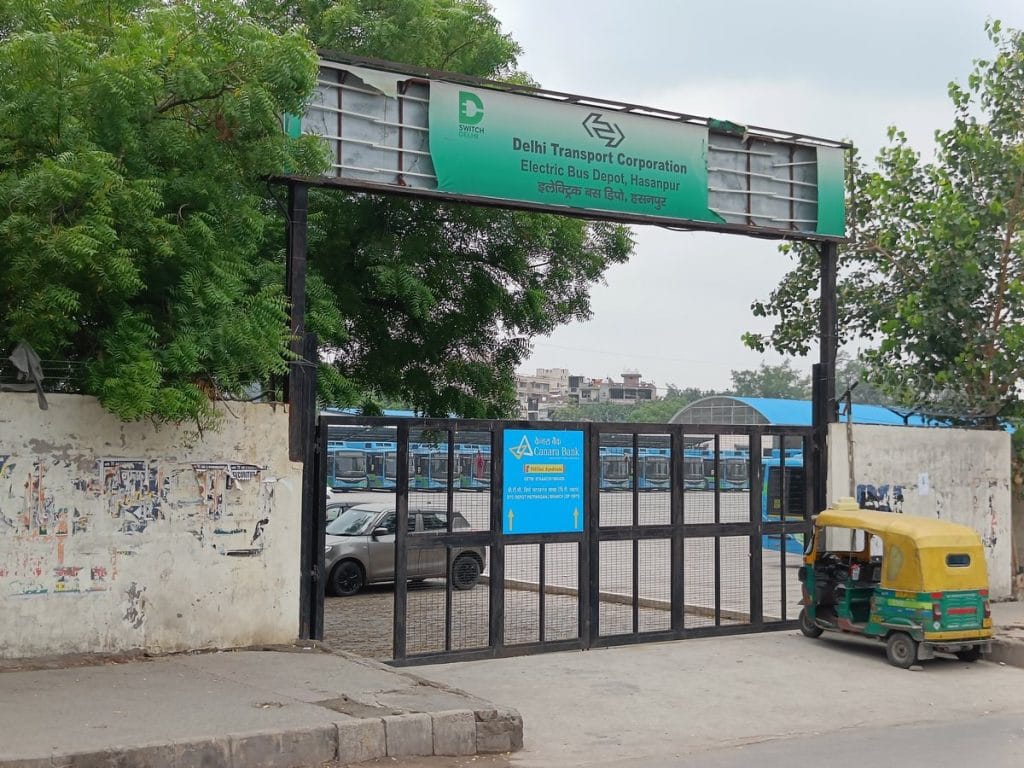
Earlier this month, Tamil Nadu Chief Minister MK Stalin flagged off 120 low-floor electric buses in Chennai—the state’s first.
The Modi government, meanwhile, is implementing its PM e-Drive Scheme in major cities. In May, the Ministry of Heavy Industries announced 4,500 e-buses for Bengaluru, 2,800 for Delhi, 2,000 for Hyderabad, 1,000 for Ahmedabad, and 600 for Surat in the current phase. The scheme aims to deploy 14,028 electric buses with a total financial outlay of Rs 10,900 crore from April 2024 to March 2026.
“We are not merely allocating electric buses—we are shaping the future of India’s transport system with innovation and environmental consciousness,” said HD Kumaraswamy, Union Minister for Heavy Industries and Steel.
Also Read: Buses, not metros, are key to fixing India’s urban transport mess. Learn from London
The pink promise
For 36-year-old Shabnam, getting a call from DTC in 2022 changed everything. She was among the early recruits under Delhi’s Mission Parivartan, a programme launched to train women to drive heavy motor vehicles.
Today, Shabnam drives a CNG bus out of the Noida depot.
“In four months, my depot will get e-buses. I want to drive one,” she said.
Four months ago, Shabnam completed her electric bus training at Nandnagri Training School—a six-day programme for all DTC drivers transitioning to electric vehicles.
“Passengers were suffering on the roads due to shortage of buses. Now, the scenario has changed with the coming of new buses with many modern facilities,” she added.
In the last three years, the number of women bus drivers in DTC has grown from none to around 100. The push for women on buses wasn’t just behind the wheel. In 2019, the Kejriwal government introduced free bus travel to women in DTC buses with “pink tickets”.
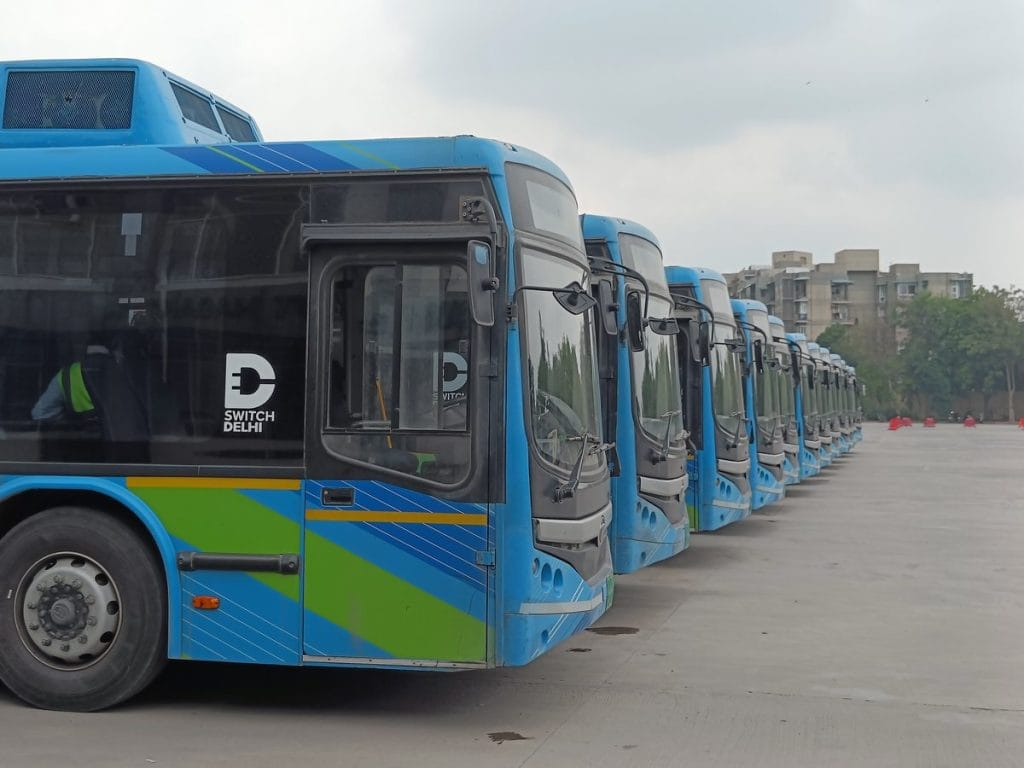
The scheme helped women passengers save up to 8 per cent of their monthly income, according to a working paper, Fare-free bus travel scheme for women : Lessons from Delhi, by the World Resources Institute (WRI).
From 2019 to 2024, the AAP government had provided women in Delhi free bus rides 153 crore times. Former Finance minister Atishi said during last year’s budget that around 11 lakh women travel for free every day.
According to Delhi’s 2024-25 Economic Survey, the number of pink tickets was 17.7 crore in 2020-21, which increased to 40 crore in 2022-23.
Four years after pink tickets were rolled out in Delhi, Karnataka’s Congress government followed suit. In 2023, it launched the Shakti scheme modelled on Delhi’s. In just two years, it has recorded 475 crore free bus rides by women. This year, Andhra Pradesh officials visited Karnataka to study its model.
Under Delhi’s new BJP government, the pink ticket programme continues—but not without criticism. The Delhi transport minister has alleged widespread misuse.
“We conducted raids after we came to power and found fake pink tickets being generated, just so that the government exchequer could be depleted,” he told ThePrint at his secretariat office. “We will put a proper system in place.”
But for Satya Prakash at Hasanpur depot, what matters above all else is more buses.
“DTC has got a fresh lease of life after a decade but it needs time to overhaul the system. Procuring more and more buses can only solve the DTC crisis,” he said.
(Edited by Asavari Singh)



